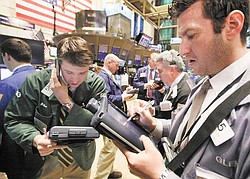S&P’s warning could help US debt
ASSOCIATED PRESS
In this file photo taken March 16, 2011, traders work on the floor of the New York Stock Exchange. Upbeat U.S. earnings buoyed stock markets around the world Thursday, April 21, ahead of another round of company reports, while the euro neared a one-and-a-half year high against the dollar as investors were willing to take on more risky trades.
Associated Press
NEW YORK
A warning from Standard & Poor’s that mounting debts put the U.S. government’s credit rating at risk blindsided markets last Monday. The Dow Jones industrial average lost more than 240 points in the morning before recovering. It was the worst one-day drop for stocks since fears over a nuclear meltdown in Japan sent investors into hiding March 16.
The response made sense. A downgrade of U.S. debt, after all, could turn into an economic calamity. Here’s the surprising part: After a quick dip, prices for U.S. government debt began rising.
Economists and bond traders offer varying explanations for the Treasury market’s curious reaction, but there’s a common thread: S&P’s warning shot could actually wind up making bonds more attractive.
If an actual downgrade were to occur, the effects would ripple through financial markets. When S&P lowers the credit rating on a country, it’s saying that there’s a greater chance the country won’t pay its debts. Creditors demand higher borrowing rates. In the U.S. it would mean higher interest payments for the federal government. All borrowers — from companies, home-owners to credit-card users — would find it harder to borrow. Presumably, bond prices would fall.
The strength of Treasurys, the very debt that S&P said was at risk, left many observers confused. Aren’t U.S. government bonds more dangerous now?
One reason that traders say Treasurys have looked surprisingly stable is the belief that S&P’s move could spur action in Washington to tackle the country’s debt.
In recent weeks, Paul Ryan, the Republican chairman of the House Budget Committee, and President Barack Obama had outlined plans to shrink budget deficits. Even if they were far from sharing common ground, the proposals generated a sense of progress, says Nick Kalivas, vice president of financial research at MF Global. “There was a sense that we’re going to get something done,” he says. “The move by S&P reinforced that.”
Kalivas and others say the threat of a downgrade may push congressional Republicans and the Obama administration to reach an agreement on tackling the country’s long-term debts.
 43
43

